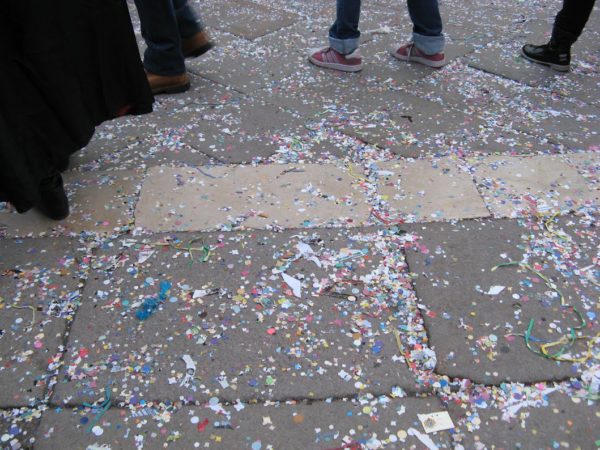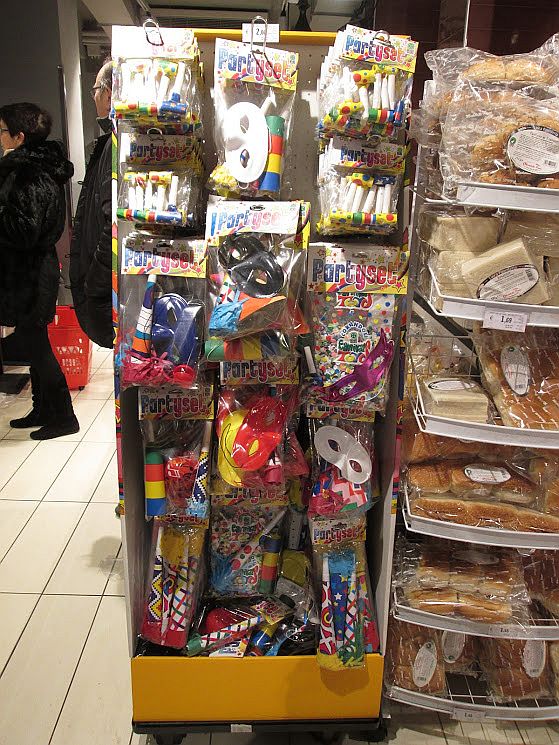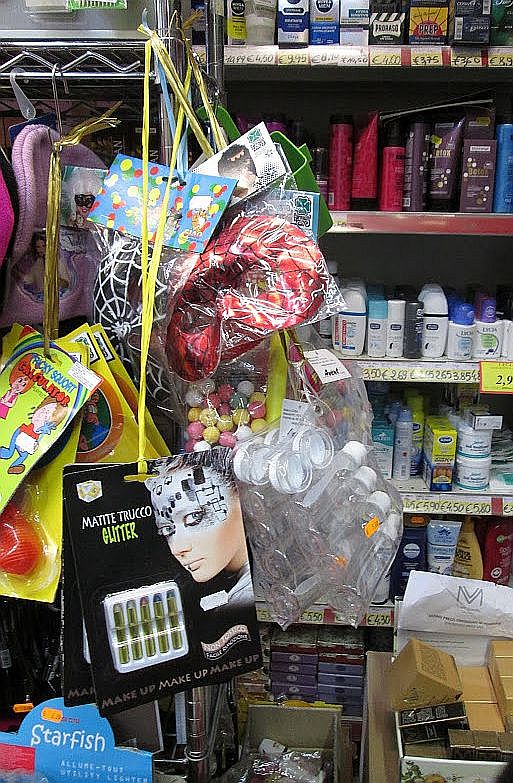Search results
83 results found.
83 results found.
Today is Martedi’ Grasso (Mardi Gras) and Carnival is wrapping up. It wrapped up a few days ago in via Garibaldi, not with a bang, not with anything. On Giovedi’ Grasso, the stage, inflatable slide and trampolines were going full tilt, overrun by swarms of unchained children. The day after, nothing. Everything was just … gone.
There are still frittelle and galani on sale and the streets are still speckled with confetti, yet the revelers are nowhere to be seen. I think whoever’s still around has migrated to the Piazza San Marco, where the big closing events take place. I won’t be there. I’ll be sitting at home in the dark, like some addict, secretly eating the last of the galani.




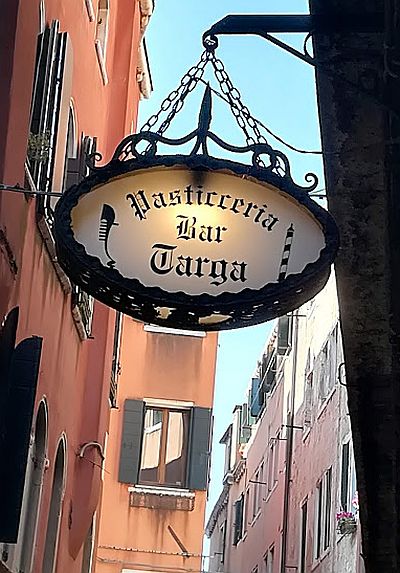
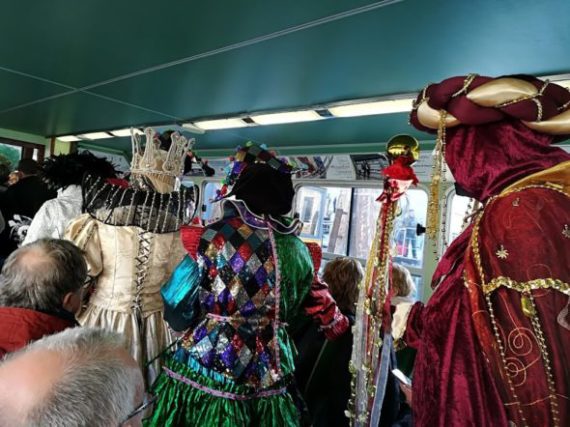
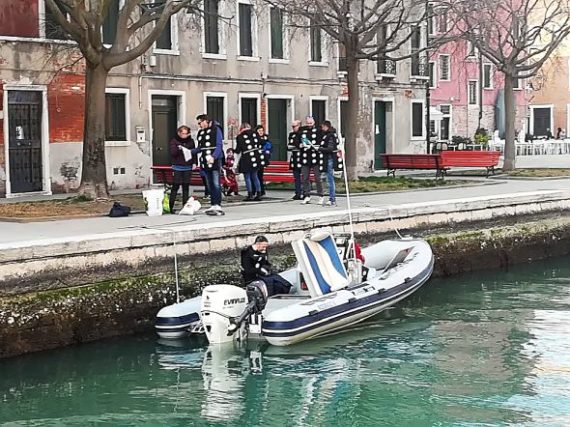





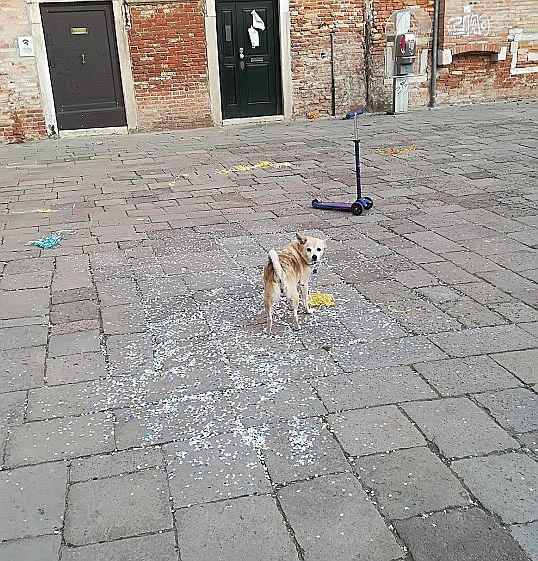
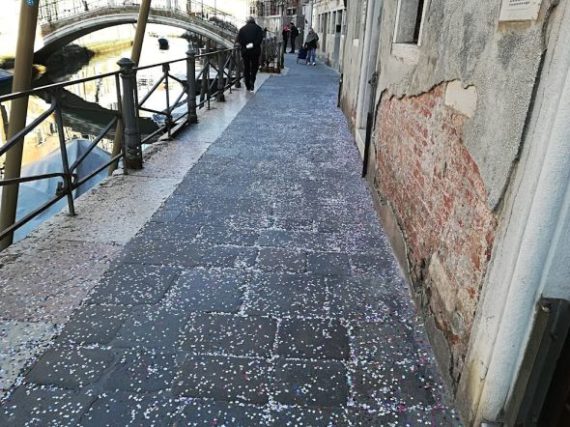


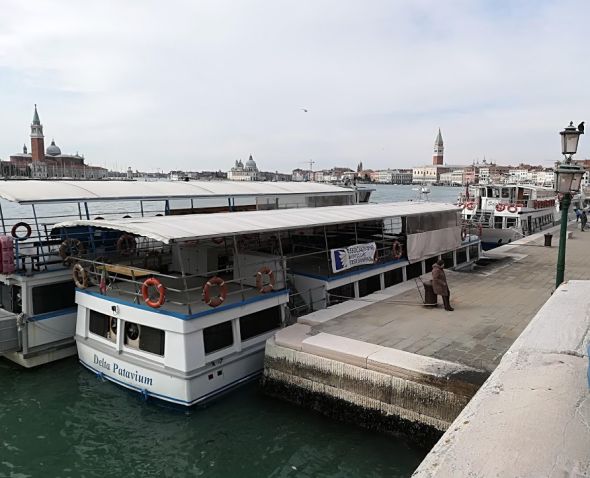
Last Saturday (Feb. 23) was the semi-official opening of Carnival, which means tremendous hubbub in deepest Castello. The frittelle and galani are already making inroads on everybody’s glucose levels, and by the look of the calli, confetti appears to be strewing itself.
The centerpiece of Saturday’s inaugural celebrations was the procession of the 12 “Marias” from San Pietro di Castello to the Piazza San Marco. Weather cold but sunny, not much wind — perfect for everybody, especially the Marias who, if the morning bora had lasted, would each have needed a can of hair spray to keep her tresses under control. Perfection comes at a price, and in this case it would either have been a week’s worth of washing with Packer’s Pine Tar shampoo or a visit to the Navy barber for a cut measured in millimeters. People love looking at the girls, but I worry about their hair. It probably comes with age.
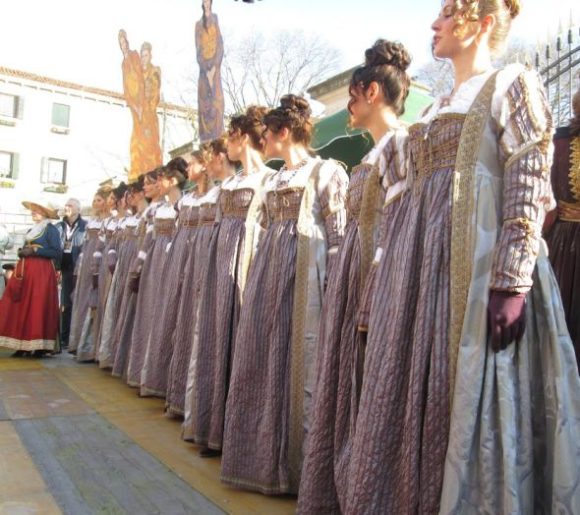
Sunday (Feb. 24) at 11:00 AM was the true official opening of the annual scrum, with the “Volo del Angelo” (flight of the angel) enacted by a lovely girl in magnificent garb who slides down a wire from the campanile of San Marco to terra firma at the stage below. She was followed by another, because why stop at one? In this case I don’t worry about their hair, I worry about their lives. As does everyone. All went well.
The most important innovation was the installation of turnstiles at the entrance to the Piazza; for the first time, the number of festivizers permitted in the Piazza was limited to a modest 23,000, with corridors arranged for easy entry and exit. Modern, intelligent, efficient — it can be done! I don’t know where the rest of the 110,000 people that were counted in the city went, but my tricorn hat with the veil is off to the organizers and the enforcers, all 700 of them: 420 vigili, or municipal police (100 more than last year, between Venice and the mainland), 60 firemen, 120 workers from Vela (transport), 40 of Suem and Croce Verde (ambulances) e 40 of Civil Protection (general assistance and crisis management).
La Nuova Venezia reported that there were many more people than last year. “In spite of some suffocating stretches, some calli transformed into a Stations of the Cross (you can intuit this means slow and extreme suffering), and some campi, such as Santa Maria Formosa, full to overflowing, there weren’t any complications.” They are referring to quantity, not quality, because…..
Turista barbaricus is back! Two young foreigners were nabbed at 10:00 AM on Sunday in the Piazzetta dei Leoncini urinating against the basilica of San Marco. Hey! A wall! Just what we needed! Nabbed by the police, each has been given a fine of 3,330 euros ($3,782). That will certainly make for an interesting conversation when they get home. Just think: For the price of a coffee (1.10 euros) they could have used the bar’s bathroom. Or hey — the canals are free! I realize that Carnival was created for breaking rules, flouting convention, freeing oneself of all those rigid rules that so strangle happiness and frivolity. I even wrote about it. Except that even the Venetian Republic didn’t need much time to recognize that there is a limit to everything, including fun, and to start passing decrees and ordinances to keep total chaos at bay.
Because I don’t venture as far as San Marco — and not even as far as the Arsenale — my view of Carnival is limited to our little lobe of the city, and that’s fine with me.

The story of the “Marias”: From the 9th century it was the custom in Venice, on the Feast of the Purification of Mary (Feb. 2, or “Candelora”), to bless all the couples who were planning to marry that year. For the ceremony, which was held in the bishop’s palace, the 12 poorest damsels were dressed in splendid garments and jewels lent by the main churches of the city. They didn’t have to be beautiful (as required by today’s pageant), they just had to be poverty-stricken.
In 973 (or maybe 948), the ceremony was interrupted by the arrival of a band of wild Slavic pirates from the Croatian coast, who stole the girls and, of course, their expensive garb and jewelry. Doge Pietro Candiani III organized a posse, caught up with them at Caorle, slew the pirates and brought the girls and their stuff home safe and — one hopes — still sound. To thank the Madonna for her intercession in this happy outcome, the Feast of the Marias was instituted.
But something had changed. Instead of choosing merely the 12 poorest girls, now they had to be the most beautiful of the poorest. Each girl was assigned to a wealthy family which donated clothes, jewels, and a dowry to help her marriage chances.
Wikipedia (in Italian, translated by me) tells us that “In the following days there was a series of civil and religious ceremonies that culminated in a boat procession on the Grand Canal, during which the “Marias” displayed their beauty and their jewels. The ceremonies were accompanied by balls, banquets and other extravagances; furthermore, to see the Marias was considered a sign of good luck, beyond being a festival for the eyes of the masculine public. And so the festivities extended over many days (even two weeks) and attracted many people from other countries.”
Sound good? Not really. Because now there were 12 poor — literally and figuratively — girls involved in what amounted to a struggle to the death among 12 patrician families. “The feast of the Marias created not a few problems; it often happened that the girls who were about to be married were courted, and in the worst cases violated, by the men who went to see them. Furthermore, the competition of the Marias caused bitter conflicts between the families, those that were poor (who, in the case of losing, protested the lost victory) as much as those who were rich (who didn’t want to take on the costs involved).
“So the flesh-and-blood girls were gradually replaced by statues of wood, called Marione or Marie de tola (wooden Marias). These were dressed and bedecked with jewels, but unlike their human counterparts weren’t furnished with dowries, and at the end of the feast the trappings were returned to their legitimate owners. But this new version of the festa lost a lot of its original sense, and along with it the favor of the Venetians, who reacted with anger and scorn, even going so far as to attempt to sabotage the festa.
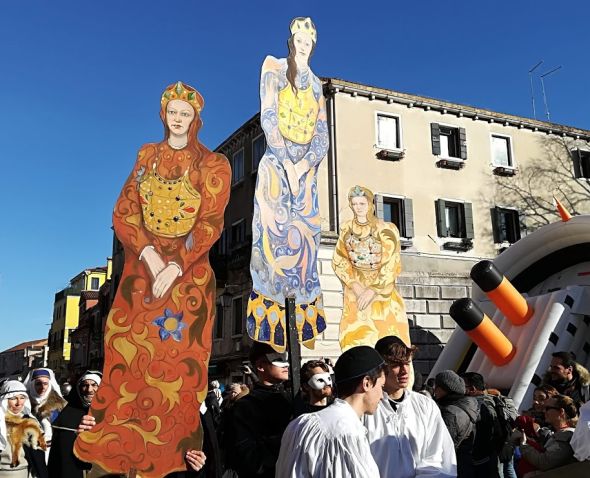
“In 1349 the Republic of Venice had to pass a law stating that anybody who threw vegetables at the procession of the wooden Marias would be sent to the galleys; this, though, only made the festa lose even more of its prestige, and only 30 years later it was definitively suppressed.”
Fun fact: “It seems that the term “marionette” is derived from the Marione. And even today it’s common to hear Venetians call a woman who is particularly dull and inexpressive a Maria de tola.” Even though I’ve never heard Lino use this expression, he confirms that it’s a common saying. Maybe we just don’t know any women who answer to that description.

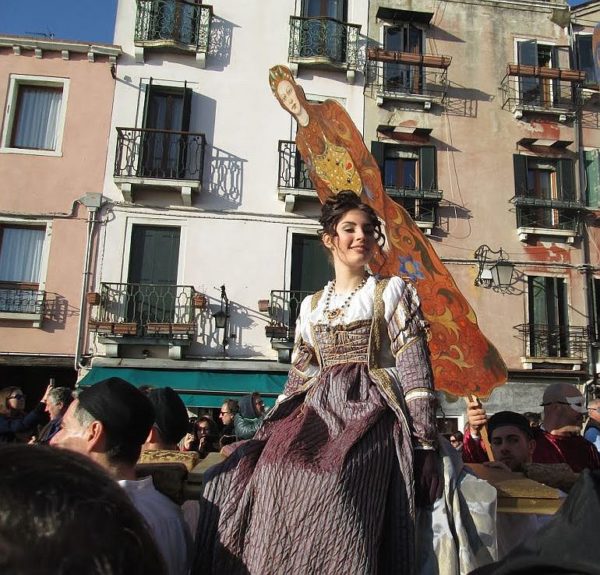

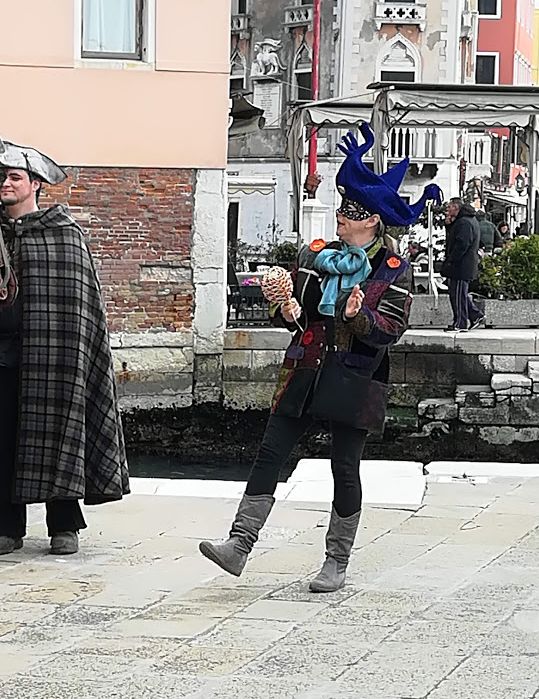


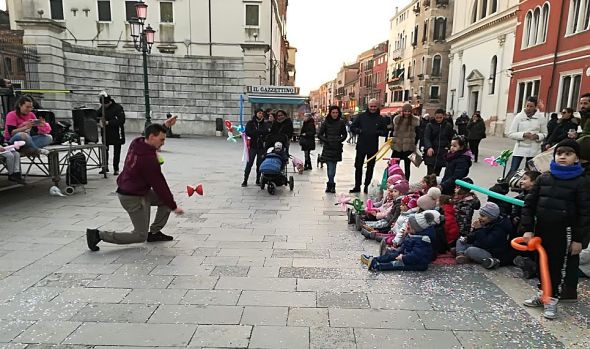
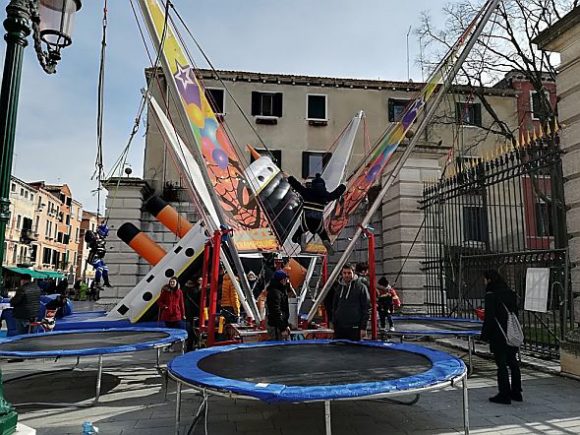
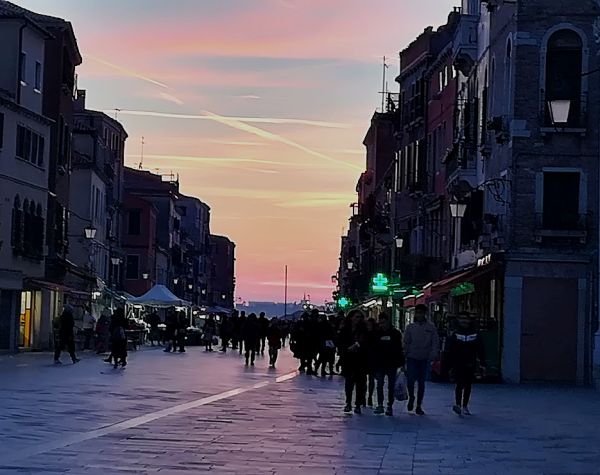
Yesterday was the second day of Carnival 2018 (Jan. 27-Feb. 13), and the festivities started, as they have for a number of years now, with a monster boat procession in the Grand Canal. The boats and rowers were decorated and trimmed and upholstered and whatever else seemed good across the gamut from minimal (a hat) to the glamorous (let’s all be Mozart for a day!) to the fabulously imaginative, funny, and irreverent. They say that during “Carnevale, ogni scherzo vale” (during Carnival every joke works) and the boat people showed they’ve got plenty of high jinks still in them.
Note: For an overview of Carnival garb, behavior and general atmosphere back in the glory days, I recommend my very own piece on masks for Craftsmanship magazine.
Further note: I promised Lino that I would convey his belief that this festival, amusing and picturesque as it may be, is NOT the real Venetian Carnival. He is extremely firm on that point. Other cities, most particularly Viareggio, are famous for celebrating Carnival with highly elaborate floats (“carri allegorici“). The floats of Viareggio are titanic constructions that can hold their own against any other carnival in the galaxy. But Lino contends that this sort of parade is not the Venetian Carnival and he strongly objects to the introduction of this foreign body into the Venetian culture. I am not going to adjudicate the matter in any way, I have only fulfilled my promise to add his voice into the festive confusion. Confusion there has always been during Carnival, even here, and history attests this. But no carri allegorici.
That said, I’d like to return to the floating (sorry) festivities. I’m a stout defender of Venetian traditions, but I have to admit that I found the whole thing hugely entertaining. That’s all I’m going to say.
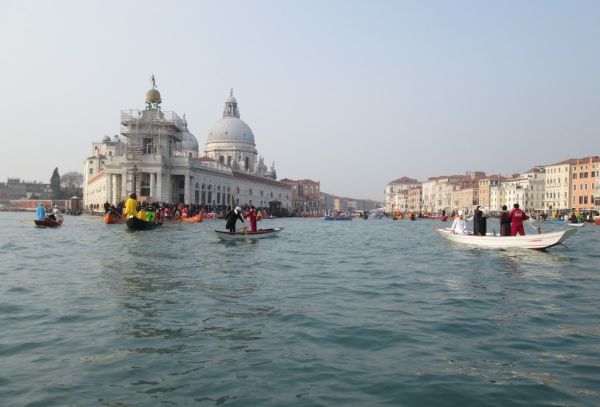
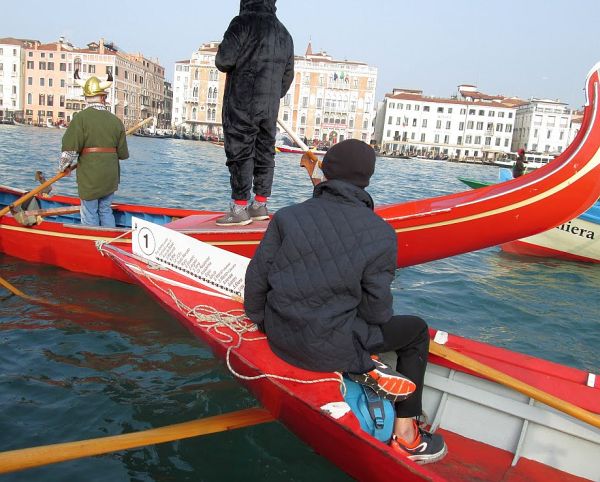
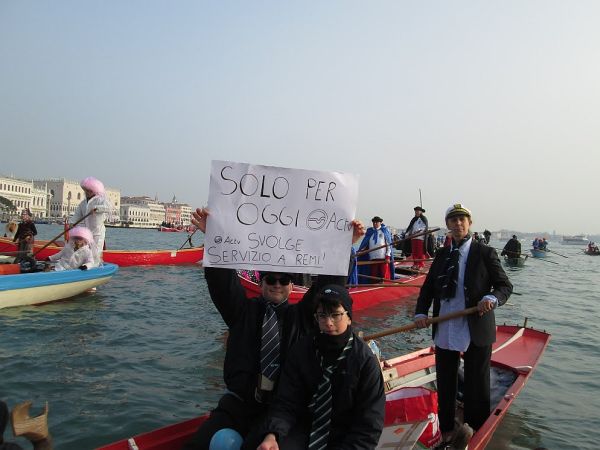

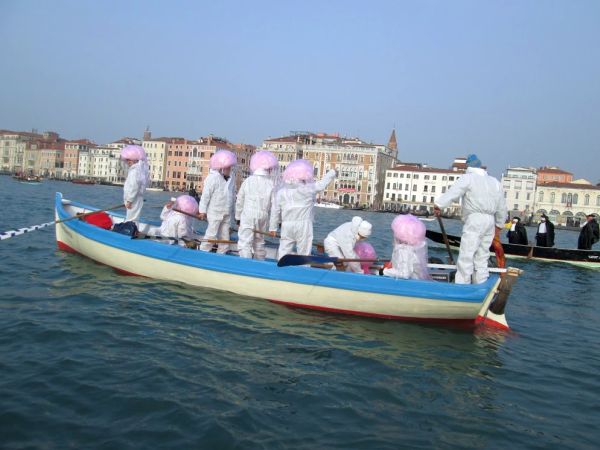
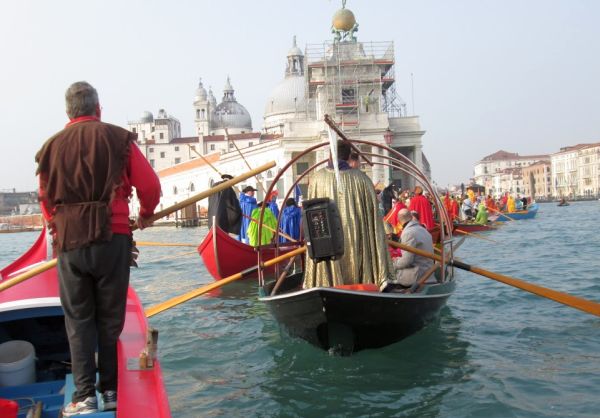
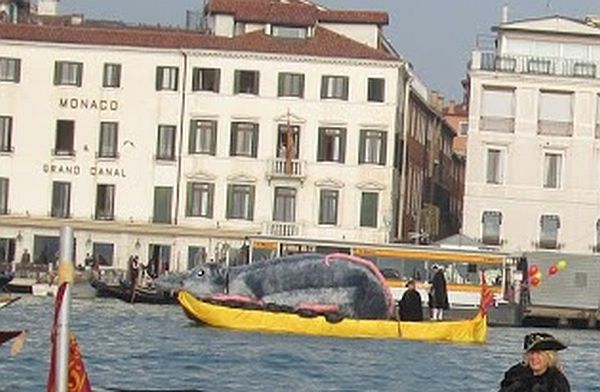
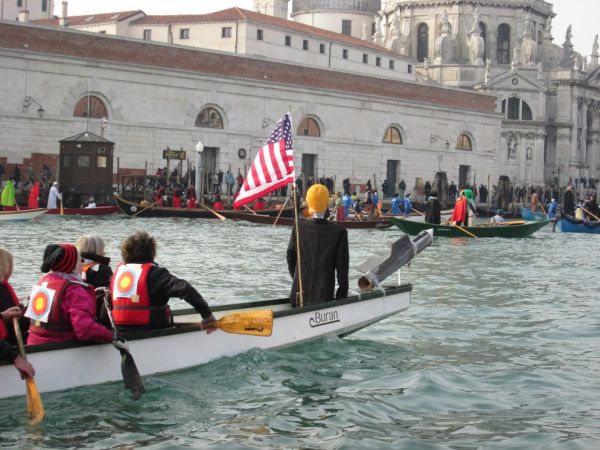
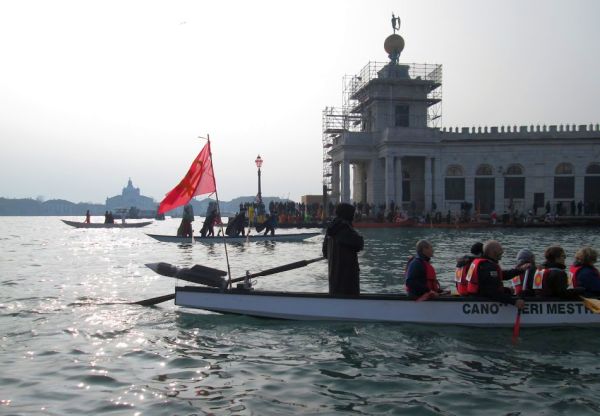

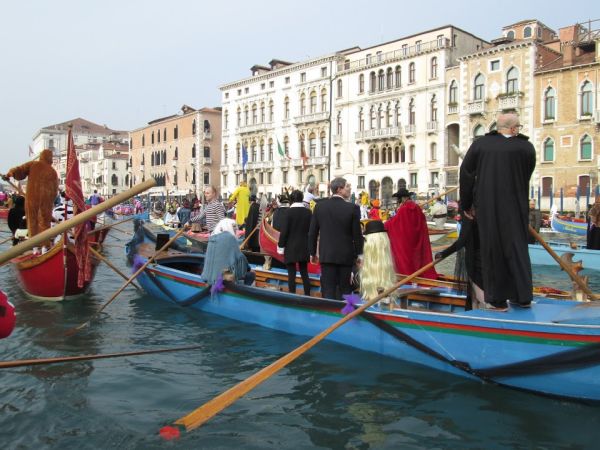
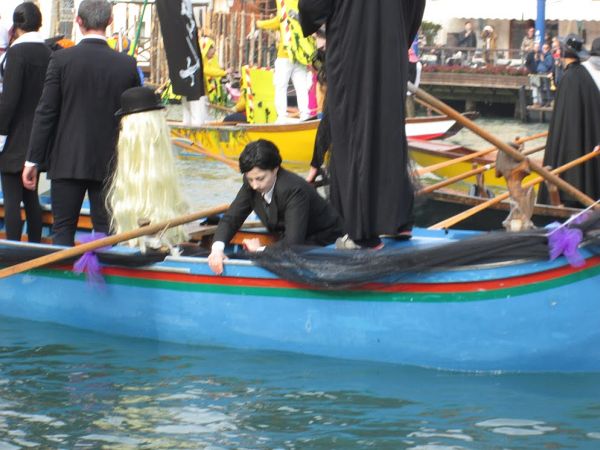
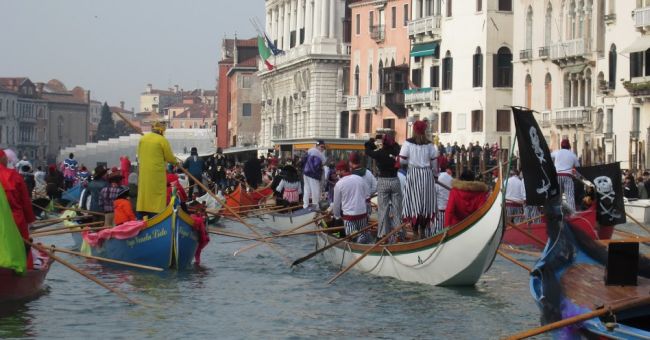
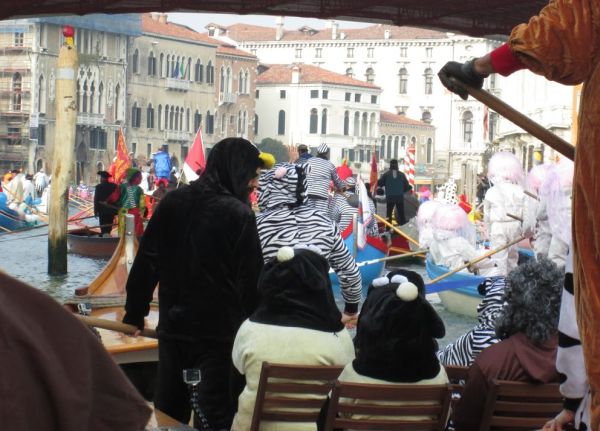

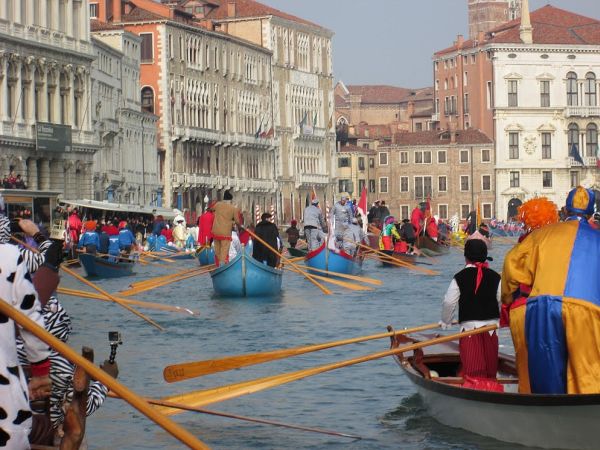

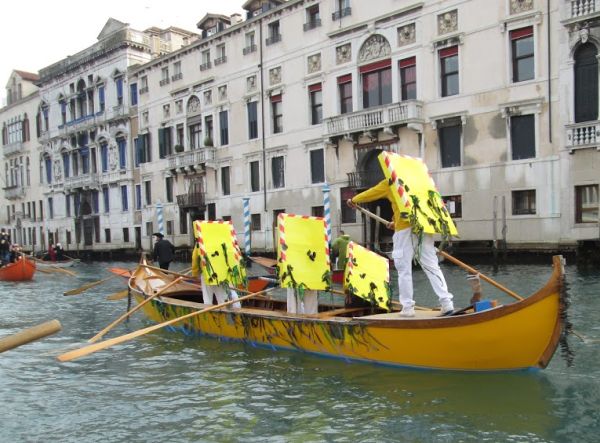

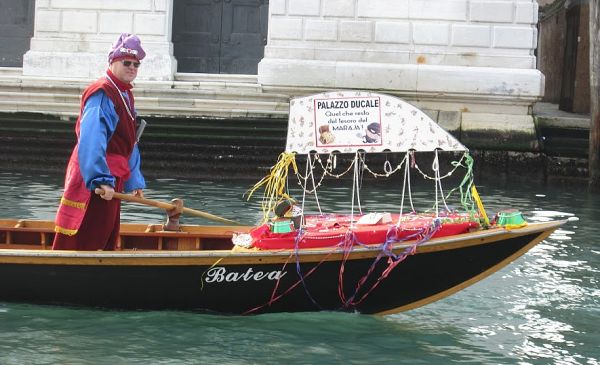
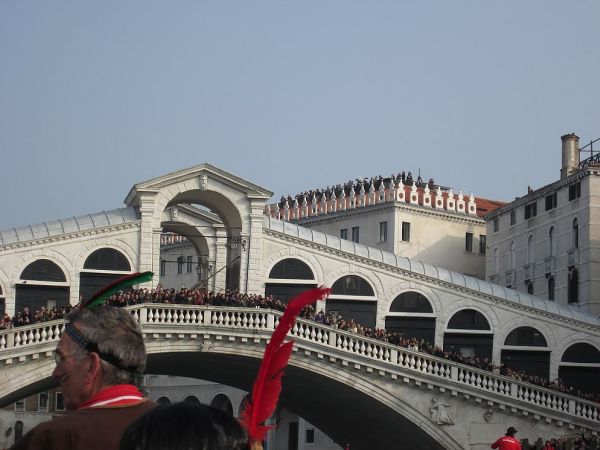

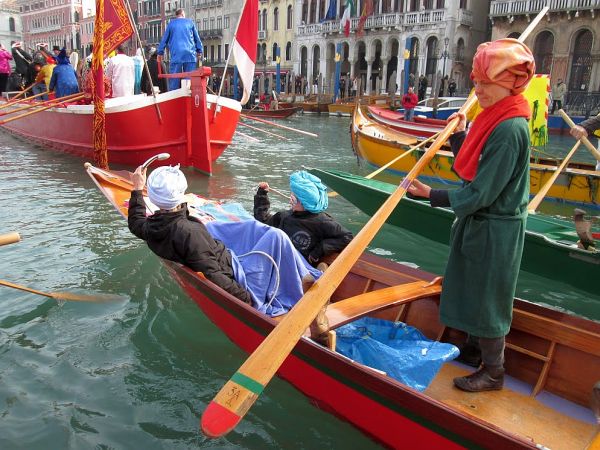
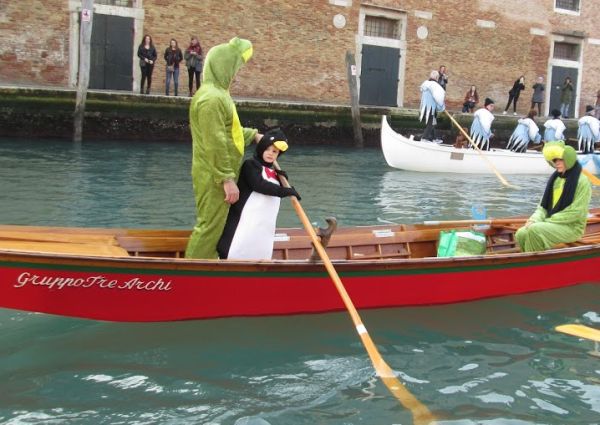
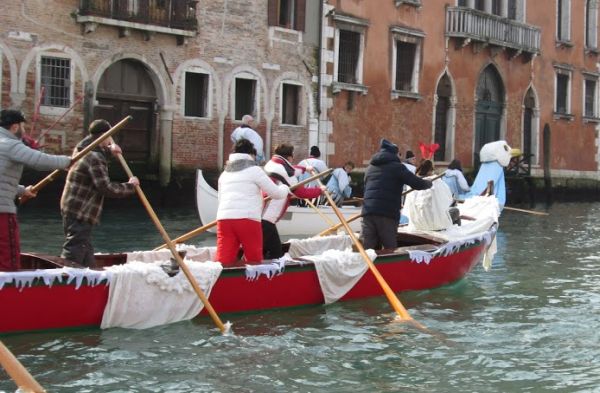
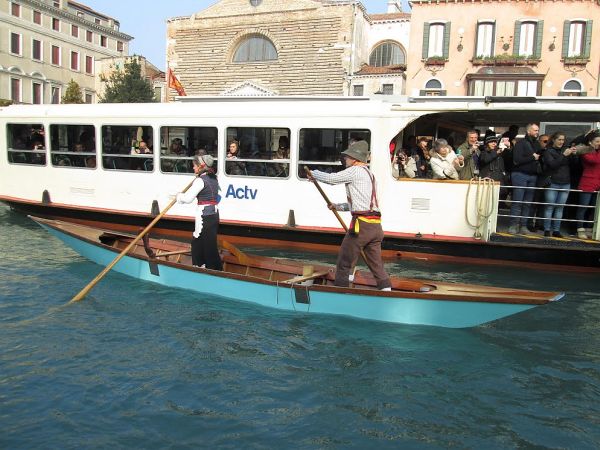

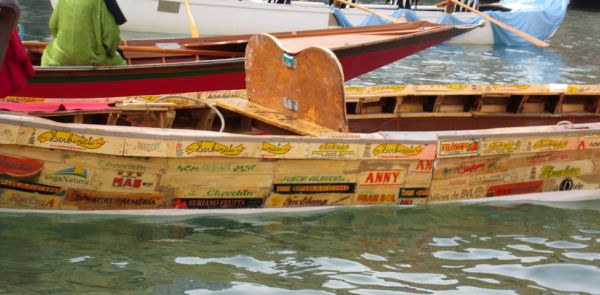
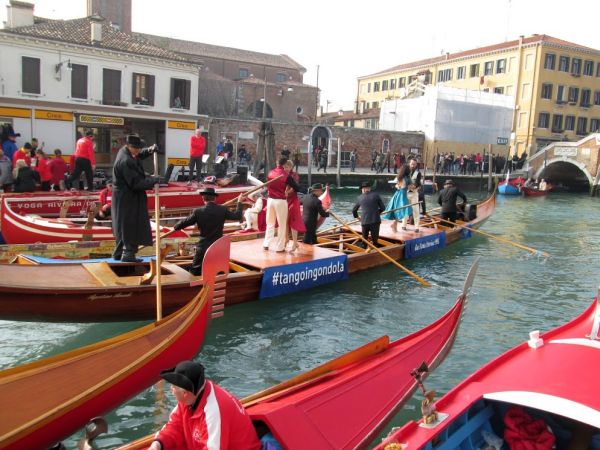
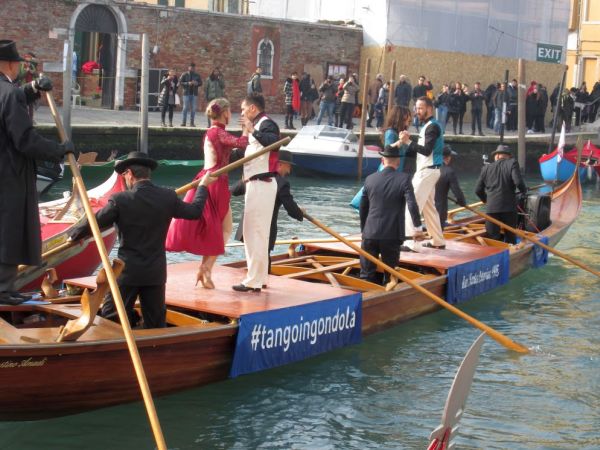
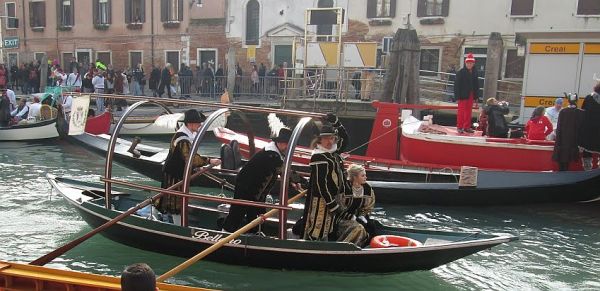
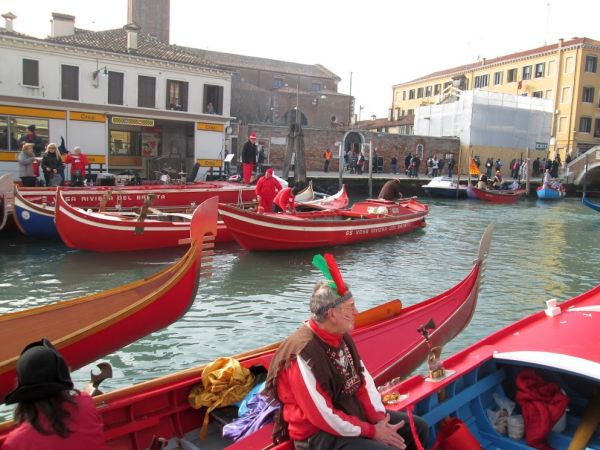
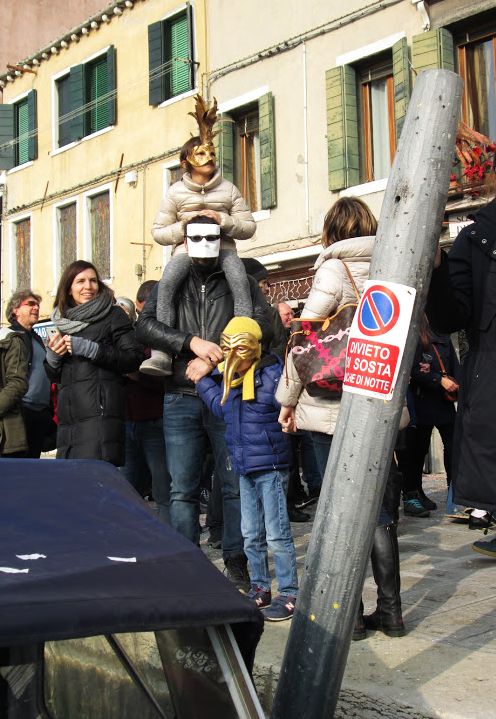

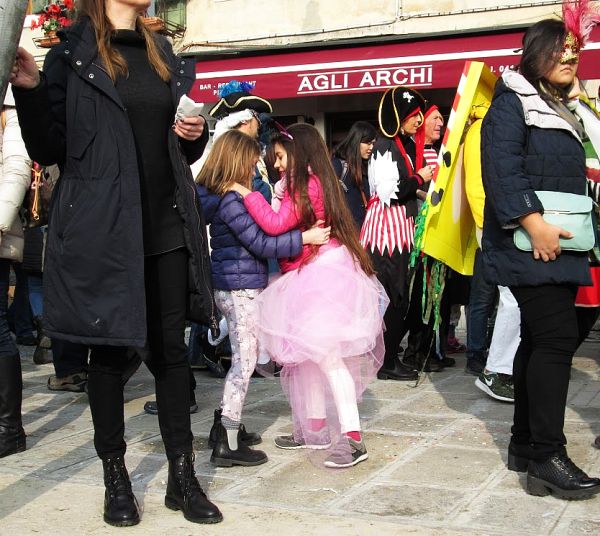
This year Carnival is starting early, thanks to the lunar schedule which governs Easter (January 27 – February 13, if you’re keeping track; two and a half weeks, which seems long, but it’s three weekends, which is what really matters). Therefore we are enjoying a shorter-than-usual interlude of calm and tranquility between Epiphany and the aforementioned Carnival — a mere three weeks, which isn’t nearly long enough to take all those deep breaths you so urgently need. But there’s no arguing with the Paschal Full Moon, counting backwards from, and I imagine the city fathers would be happy for it to run for six months, as it did in the olden days, considering how much lucre spills into the municipal coffers therefrom.
What I am enjoying are the jolly signs of its approach. Here are just a few glances around the neighborhood. And yes, as every year, the frittelle are appearing in the pastry shops, and wild swaths of confetti have already been seen strewn across the pavement. I notice that the garbage-collectors have been sweeping them away. Why? They’re not a health hazard. They’re not a safety hazard. They’re not ugly or offensive. I wouldn’t have thought it possible to find yet another reason to complain about the garbage-collectors-and-sweepers, but I can’t see why they don’t devote whatever small, random spasms of energy they may experience with their brooms to sweeping away real trash, and just leave these merry little fragments of frivolity on the pavement, where they can cheer people up. But so many things perplex me, no point in picking just one.
